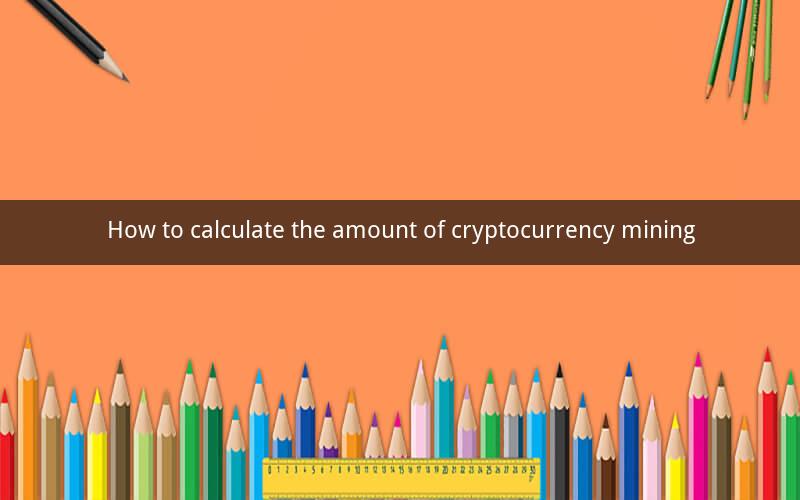
Table of Contents
1. Introduction to Cryptocurrency Mining
2. Understanding Hash Rate and Mining Difficulty
3. Importance of Electricity Costs in Mining
4. Factors Influencing the Amount of Cryptocurrency Mining
5. Calculating Mining Rewards
6. Efficient Mining Equipment
7. Joining a Mining Pool
8. Choosing the Right Cryptocurrency to Mine
9. Staying Updated with Mining Trends
10. Conclusion
1. Introduction to Cryptocurrency Mining
Cryptocurrency mining is the process of validating and adding new transactions to a blockchain, creating new coins in the process. Miners use computers to solve complex mathematical puzzles, and the first one to solve the puzzle is rewarded with cryptocurrency. Mining has become a popular way for individuals to earn a profit in the digital currency space. To calculate the amount of cryptocurrency mining you can expect to earn, there are several factors to consider.
2. Understanding Hash Rate and Mining Difficulty
Hash rate refers to the number of calculations that a miner's computer can perform per second. A higher hash rate means the computer can solve mathematical puzzles faster. Mining difficulty is a measure of how challenging it is to solve the mathematical puzzles. As more miners join the network, mining difficulty increases, making it harder to mine new coins.
3. Importance of Electricity Costs in Mining
One of the most critical factors in cryptocurrency mining is electricity costs. Miners require a significant amount of power to operate their equipment, and high electricity bills can eat into their profits. It is essential to find a balance between the hash rate of your equipment and the cost of electricity to ensure a positive return on investment.
4. Factors Influencing the Amount of Cryptocurrency Mining
Several factors can influence the amount of cryptocurrency mining you can expect to earn, including:
- Hash rate: The higher the hash rate, the more cryptocurrency you can mine.
- Mining difficulty: As mining difficulty increases, the number of coins you can mine decreases.
- Block reward: The number of coins you receive for mining a new block.
- Transaction fees: Additional revenue generated from processing transaction fees.
- Electricity costs: The amount of power your mining equipment consumes.
5. Calculating Mining Rewards
To calculate your expected mining rewards, you can use the following formula:
Expected Rewards = Hash Rate Block Reward / Mining Difficulty
This formula assumes that you are mining alone. If you are part of a mining pool, you will need to divide your expected rewards by the share difficulty of the pool.
6. Efficient Mining Equipment
Choosing the right mining equipment is crucial for maximizing your mining profits. Factors to consider include the hash rate, power consumption, and cooling capabilities. Some popular mining equipment brands include Bitmain,ASICMiner, and InnoHash.
7. Joining a Mining Pool
Mining pools are groups of miners who combine their resources to increase their chances of mining a block. Joining a mining pool can help you receive consistent rewards and avoid the risk of going a long time without mining a block. Before joining a mining pool, consider factors such as the pool's fee structure and its reputation.
8. Choosing the Right Cryptocurrency to Mine
Different cryptocurrencies have varying mining difficulties and profitability. It is essential to research and choose a cryptocurrency that offers a good balance between mining difficulty and profitability. Some popular cryptocurrencies to mine include Bitcoin, Ethereum, and Litecoin.
9. Staying Updated with Mining Trends
The cryptocurrency mining landscape is constantly evolving, with new technologies and trends emerging regularly. Keeping up with the latest developments can help you make informed decisions and adjust your mining strategy accordingly.
10. Conclusion
Calculating the amount of cryptocurrency mining you can expect to earn requires careful consideration of several factors. By understanding the importance of hash rate, mining difficulty, electricity costs, and other factors, you can make informed decisions and optimize your mining profits. Always stay updated with mining trends and be prepared to adapt your strategy as needed.
Questions and Answers:
1. What is a hash rate?
A. A hash rate is the number of calculations that a miner's computer can perform per second.
2. Why is mining difficulty important in cryptocurrency mining?
A. Mining difficulty is important because it determines how challenging it is to solve the mathematical puzzles and mine new coins.
3. What factors influence the profitability of cryptocurrency mining?
A. Factors influencing profitability include hash rate, mining difficulty, block reward, transaction fees, and electricity costs.
4. How can I calculate my expected mining rewards?
A. To calculate expected mining rewards, use the formula: Expected Rewards = Hash Rate Block Reward / Mining Difficulty.
5. What is the purpose of a mining pool?
A. The purpose of a mining pool is to combine resources to increase the chances of mining a block and receive consistent rewards.
6. Why should I consider the cooling capabilities of mining equipment?
A. Cooling capabilities are important to prevent overheating and maintain optimal performance of your mining equipment.
7. How do electricity costs affect mining profitability?
A. High electricity costs can reduce mining profitability, so it's crucial to find a balance between hash rate and power consumption.
8. What are some popular cryptocurrency mining equipment brands?
A. Some popular mining equipment brands include Bitmain,ASICMiner, and InnoHash.
9. Why should I stay updated with mining trends?
A. Staying updated with mining trends can help you make informed decisions and adjust your strategy to maximize profits.
10. What should I consider when choosing a cryptocurrency to mine?
A. When choosing a cryptocurrency to mine, consider mining difficulty, profitability, and your mining equipment's compatibility.